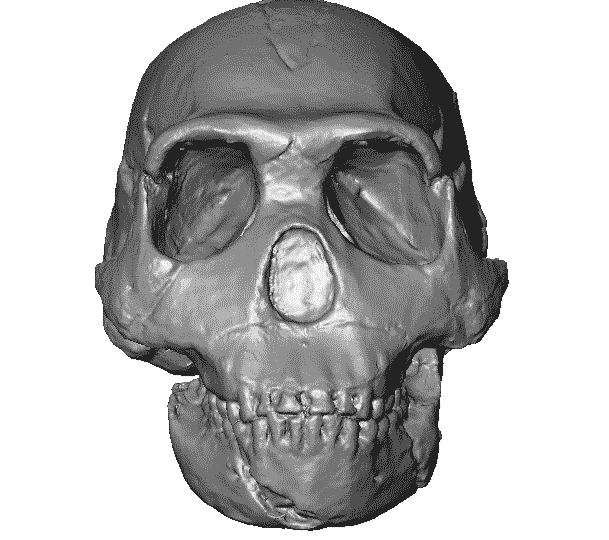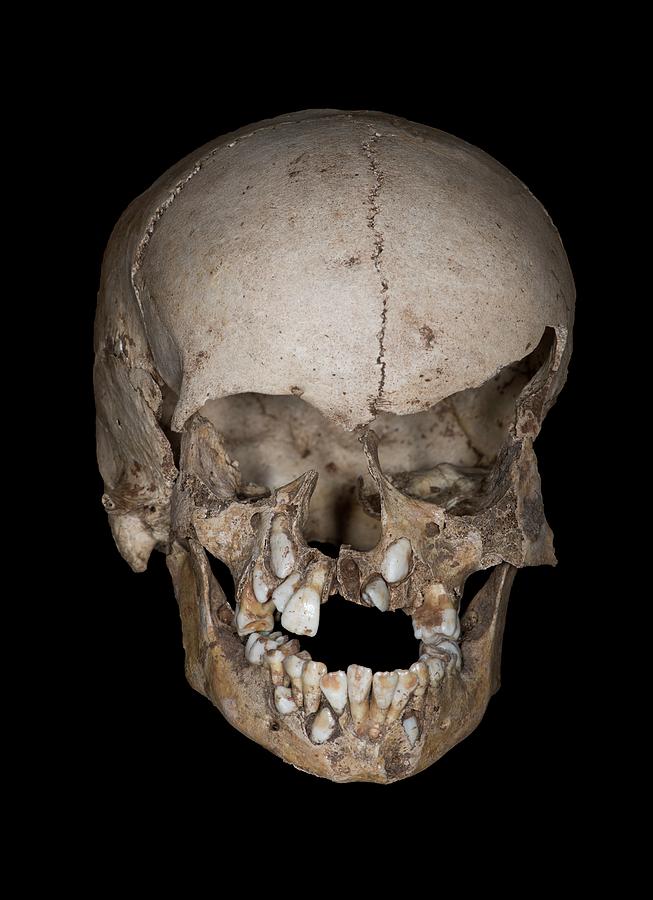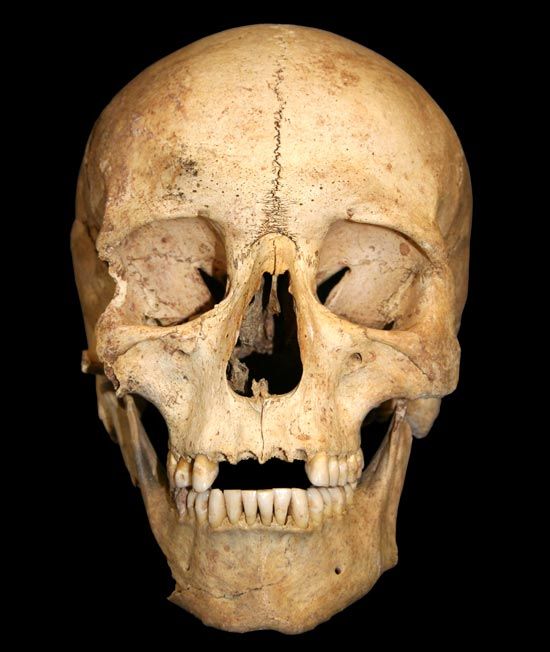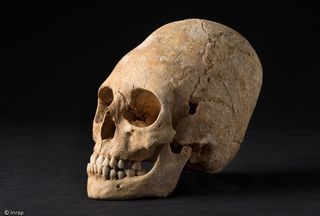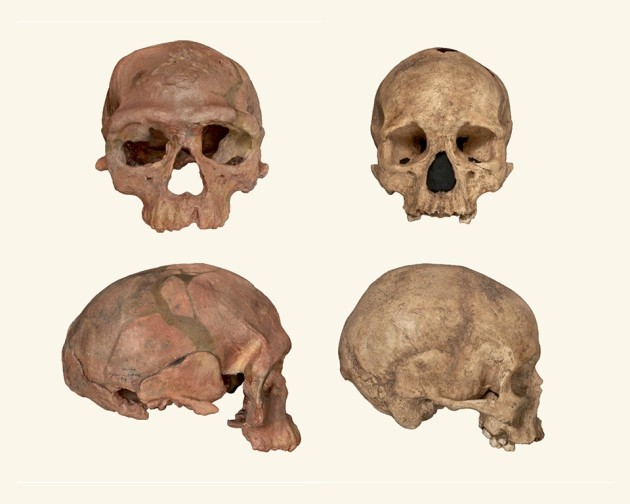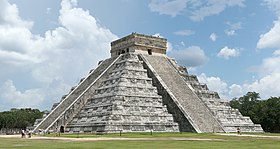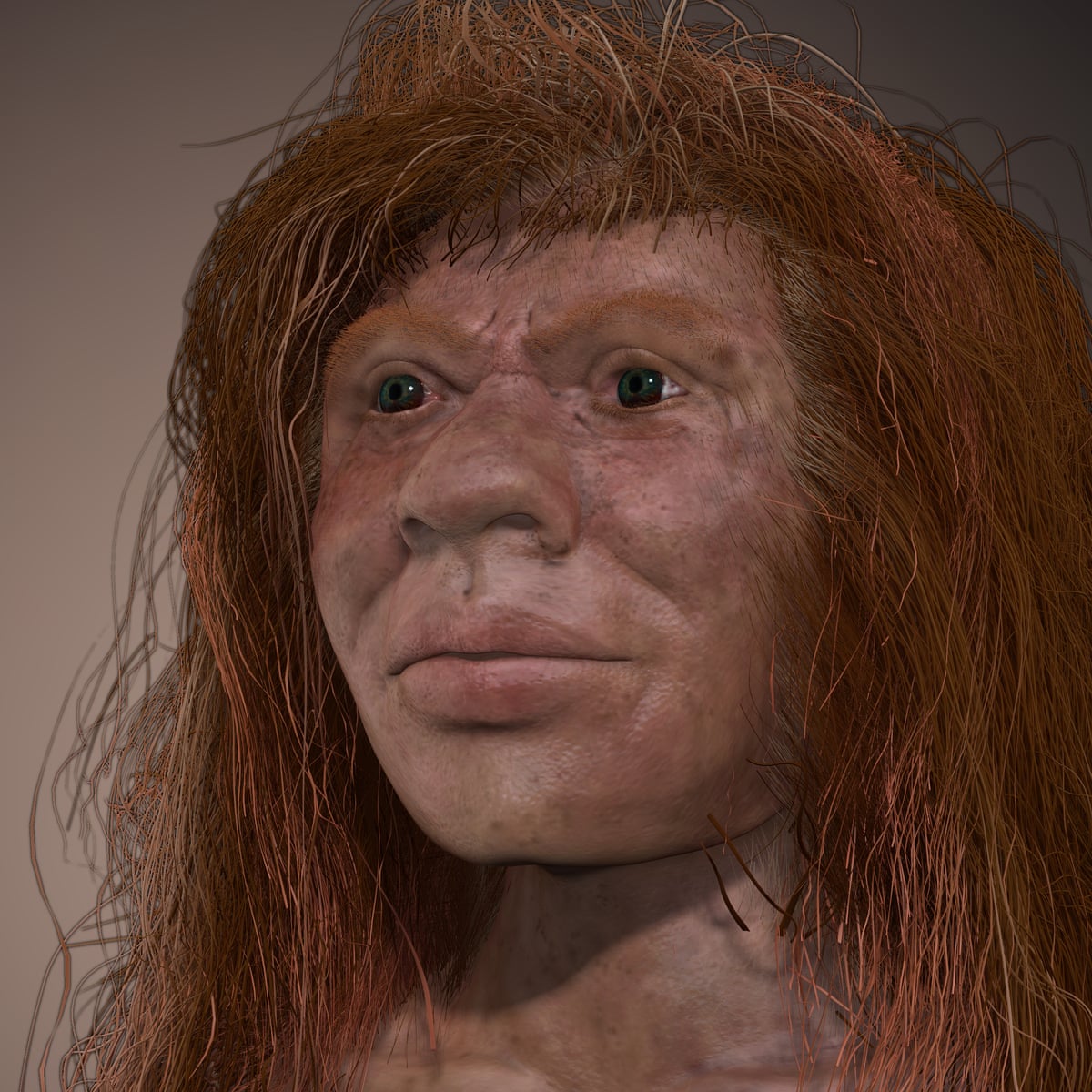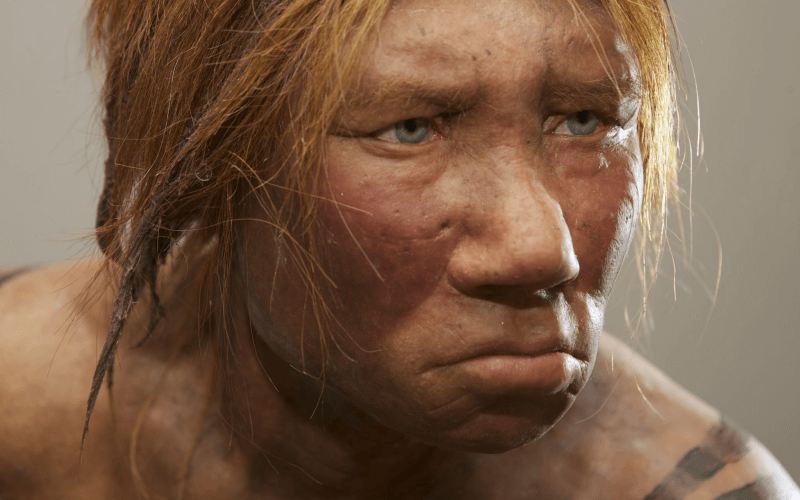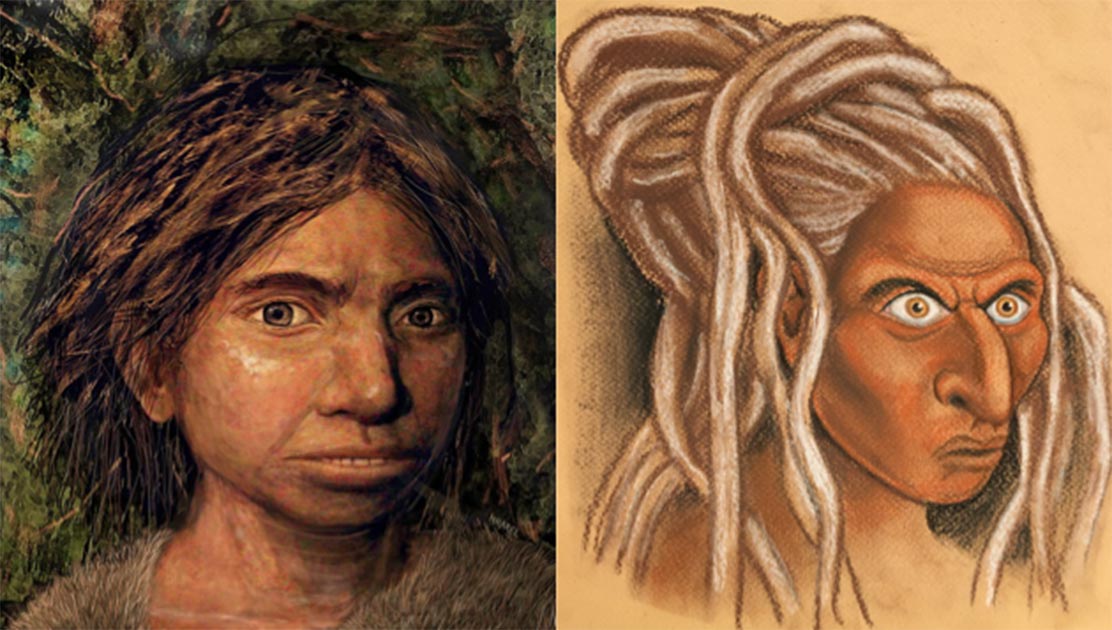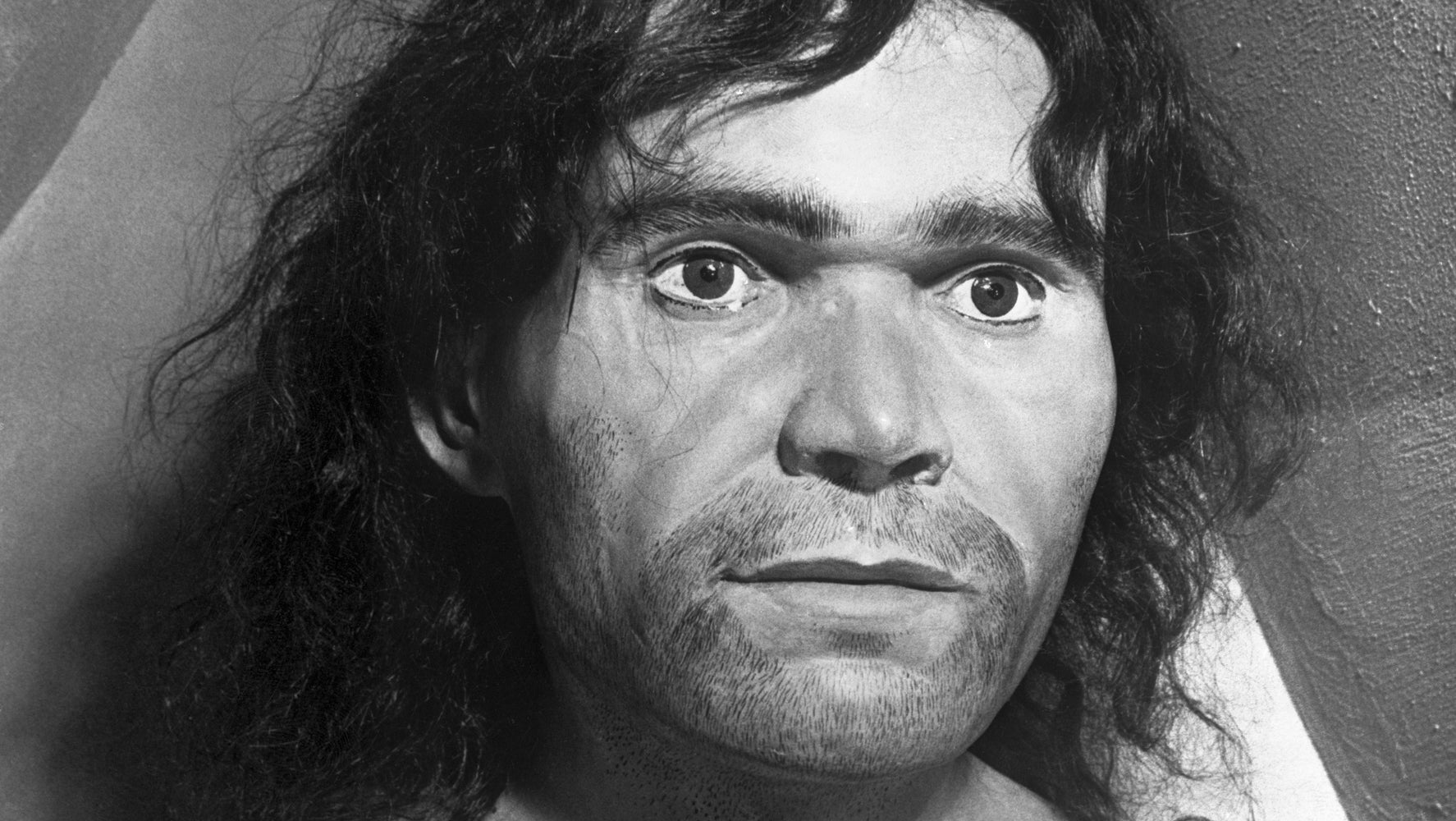

A model of the phylogeny of H. sapiens over the last 600,000 years (vertical axis). The horizontal axis represents geographic location; the vertical axis represents time in thousands of years ago.[1] Homo heidelbergensis is shown as diverging into Neanderthals, Denisovans and H. sapiens. With the expansion of H. sapiens after 200 kya, Neanderthals, Denisovans and unspecified archaic African hominins are displayed as again subsumed into the H. sapiens lineage. Possible admixture events involving certain modern populations in Africa are also shown.
Simplified phylogeny of the species Homo sapiens (modern humans) for the last 600,000 years. Based on Schlebusch et al., "Southern African ancient genomes estimate modern human divergence to 350,000 to 260,000 years ago" Science, 28 Sep 2017, DOI: 10.1126/science.aao6266 (preprint), Fig. 3: "Demographic model of African history and estimated divergences"[1]: Horizontal lines represent migration, with upward-pointing triangles representing admixture into another group. The six major divisions of modern humans are given as: Non-Africans (yellow), East Africans (orange), West Africans (red), Central African hunter-gatherers [African Pygmies] (blue), northern Khoi-San [NKSP] (green) and southern Khoi-San [SKSP] (green), mapped according to their broad historical distribution. Estimated split times given in the source cited (in kya): Human-Neanderthal: 530-690, Deep Human [H. sapiens]: 250-360, NKSP-SKSP: 150-190, Out of Africa (OOA): 70-120. For a caveat of these divergence times possibly being too early: see "Khoisan May Not Have Diverged ~300,000 Years Ago": "a prominent geneticist who is very conversant with these issues is simply incredulous about the likelihood of this particular value. I brought up this preprint to them over lunch and they just didn’t buy it. That is, they are skeptical that the amount of admixture would have skewed the earlier inferences to the magnitude that they seem to have in these results. The authors in the paper used G-PhoCS and their own ingenious method to come to these inferences of split dates. The problem with these methods is that the inferences generated aren’t nearly as straightforward as an admixture estimate (which can be checked by something as simple as a PCA)." Representation of archaic (non-Homo-sapiens) admixture is based on: Stringer, C. (2012). "What makes a modern human". Nature 485 (7396): 33–35. doi:10.1038/485033a, with modifications: H. heidelbergensis is shown as the link between Neanderthals, Denosiovans and H. sapiens Admixture of Denisovans and Neanderthals to non-African Homo sapiens after OOA Note: evidence published since 2016 makes it less likely that H. heidelbergensis is the Neanderthal-sapiens-MRCA. Neanderthal-sapiens divergence is now more likely further back, between about 700 and 800 kya, H. heidelbergensis is entirely within the Neanderthal lineage, and the mrca is more likely (identical with or close to) H. antecessor. If these recent results are to be represented in the diagram, its scope will need to be extended to 800 kya. Literature: Alan R. Rogers, Ryan J. Bohlender, Chad D. Huff, "Early history of Neanderthals and Denisovans", PNAS 114 (37), 12 September 2017, 9859-9863, doi.org/10.1073/pnas.1706426114 (Jordana Cepelewicz, Genetics Spills Secrets From Neanderthals’ Lost History, Quanta Magazine, 18 September 2017) Matthias Meyer, Juan-Luis Arsuaga, Cesare de Filippo, Sarah Nagel, Ayinuer Aximu-Petri, Birgit Nickel, Ignacio Martínez, Ana Gracia, José María Bermúdez de Castro, Eudald Carbonell, Bence Viola, Janet Kelso, Kay Prüfer & Svante Pääbo, "Nuclear DNA sequences from the Middle Pleistocene Sima de los Huesos hominins", Nature 531, pages 504–507 (24 March 2016), doi:10.1038/nature17405. (Ewen Callaway, "Oldest ancient-human DNA details dawn of Neanderthals" Sequence of 430,000-year-old DNA pushes back divergence of humans and Neanderthals", Nature News, 14 March 2016) --- Additional archaic admixture events to Sub-Saharan African populations: archaic admixture to hunter-gatherer groups (Biaka Pygmies and San), with a separation time of some 700kya: Hammer et al. (2011). "Genetic evidence for archaic admixture in Africa" (PDF). Proceedings of the National Academy of Sciences. 108 (37): 15123–15128. doi:10.1073/pnas.1109300108. archaic admixture to hunter-gatherer groups (Pygmies, Hadza and Sandawe) with a separation time of 1.2 Mya: Lachance, J. et al. (2012). "Evolutionary History and Adaptation from High-Coverage Whole-Genome Sequences of Diverse African Hunter-Gatherers". Cell. 150 (3): 457–469. doi:10.1016/j.cell.2012.07.009. PMC 3426505 Freely accessible. PMID 22840920. Age estimates on mt-haplogroups L0, L1, L2, L3: Doron et al., "The Dawn of Human Matrilineal Diversity", Am J Hum Genet. 2008 May 9; 82(5): 1130–1140, doi: 10.1016/j.ajhg.2008.04.002 African population history is more complicated and may have to be revised as more information becomes available. See: Skoglund et al., "Reconstructing Prehistoric African Population Structure", DOI: https://dx.doi.org/10.1016/j.cell.2017.08.049 not indicated in diagram: archaic admixture to West African agricultural populations (Mende and Yoruba): Xu, D. et al. (2017). "Archaic Hominin Introgression in Africa Contributes to Functional Salivary MUC7 Genetic Variation". Molecular Biology and Evolution. 34 (10): 2704–2715. H. naledi is shown as going extinct without admixture to H. sapiens; date for H. naledi: Dirks, Paul H.G.M.; Roberts, Eric M.; et al. (9 May 2017). "The age of Homo naledi and associated sediments in the Rising Star Cave, South Africa". eLife. 6: e24231. doi:10.7554/eLife.24231 early out of Africa and admixture to Neanderthals: 270 kya: Posth, Cosimo; et al. (4 July 2017). "Deeply divergent archaic mitochondrial genome provides lower time boundary for African gene flow into Neanderthals". Nature Communications. 8: 16046. doi:10.1038/ncomms16046. 130 kya: Armitage, Simon J.; Jasim, Sabah A.; Marks, Anthony E.; Parker, Adrian G.; Usik, Vitaly I.; Uerpmann, Hans-Peter (January 2011). "The southern route "out of Africa": evidence for an early expansion of modern humans into Arabia". Science. 331 (6016): 453–6. Bibcode:2011Sci...331..453A. doi:10.1126/science.1199113. PMID 21273486.
https://en.wikipedia.org/wiki/Interbreeding_between_archaic_and_modern_humans#/media/File:Homo_sapiens_lineage.svg
See also
- African archaeology
- Australopithecus sediba – Two-million-year-old hominin from the Cradle of Humankind
- Denisovan – Asian archaic human
- Homo luzonensis – Archaic human from Luzon, Philippines
- Homo floresiensis – Archaic human from Flores, Indonesia
- Neanderthal – Extinct Eurasian species or subspecies of archaic humans
- Timeline of human evolution

History of Discovery:
Fossil hominins were first discovered in the Dinaledi Chamber of the Rising Star Cave system in South Africa during an expedition led by Lee Berger beginning October 2013. In November 2013 and March 2014, over 1550 specimens from at least 15 Homo naledi individuals were recovered from this site. This excavation remains the largest collection of a single hominin species that has been found in Africa. Rick Hunter and Steven Tucker found an additional 133 Homo naledi specimens in the nearby Lesedi Chamber in 2013, representing at least another 3 individuals – two adults and a juvenile. In 2017, the Homo naledi fossils were dated to between 335,000 and 236,000 years ago.
How They Survived:
Due to the lack of other animal fossils or tools associated with Homo naledi, very little is known about the ecology and life of this species. Its teeth may provide ultimately offer clues regarding the diet and environment of this southern African species. Its teeth, in fact, differ from other Homo species that lived around the same time. So, it may be that Homo naledi inhabited a distinct environment from that occupied by other Homo species, despite having many other morphological similarities.
Evolutionary Tree Information:
The placement of Homo naledi in the evolutionary tree of the genus Homo is currently unresolved. Homo naledi possessed a mixture of traits that are Australopithecus-like (particularly in the pelvis and shoulder) and Homo-like (particularly in the hands and feet, and the size of its brain). Further comparative research is needed in order to learn more about how Homo naledi was related to Homo erectus and other species of the genus Homo.
Questions:
We don’t know everything about our early ancestors—but we keep learning more! Paleoanthropologists are constantly in the field, excavating new areas with ground-breaking technology, and continually filling in some of the gaps in understanding human evolution.
Below are some of the still unanswered questions about Homo naledi that may be answered with future discoveries:
1. How is Homo naledi related to other Homo species?
2. The hand morphology of Homo naledi suggests its use in climbing trees, whereas studies of the Homo naledi foot indicate adaptation to a terrestrial lifestyle. Why is this so? How did Homo naledi move and in what kinds of habitats?
3. Homo naledi appears to have lived near the same time as early ancestors of modern humans. Why did Homo naledi have a mixture of ancient and modern anatomical characteristics?
4. What was the diet of Homo naledi?
5. No tools have yet been found in the two cave chambers; what kinds of tools did Homo naledi make and use?
6. Were the individuals found in the Dinaledi and Lesedi chambers deliberately placed there? If so, was Homo naledi itself or another species responsible for this activity?
References:
First paper:
Berger, L.R., Hawks, J., de Ruiter, D.J., Churchill, S.E., Schmid, P., Delezene, L.K., Kivell, T.L., Garvin, H.M., Williams, S.A., DeSilva, J.M., Skinner, M.M., Musiba, C.M., Cameron, N., Holliday, T.W., Harcourt-Smith, W., Ackermann, R.R., Bastir, M., Bogin, B., Bolter, D., Brophy, J., Cofran, Z.D., Congdon, K.A., Deane, A.S., Dembo, M., Drapeau, M., Elliott, M.C., Feuerreigel, E.M., Garcia-Martinez, D., Green, D.J., Gurtov, A., Irish, J.D., Kruger, A., Laird, M.F., Marchi, D., Meyer, M.R., Nalla, S., Negash, E.W., Orr, C.M., Racovcic, D., Schroeder, L., Scott, J.E., Throckmorton, Z., Tocheri, M.W., VanSickle, C., Walker, C.S., Wei, P., Zipfel, B. 2015. Homo naledi, a new species of the genus Homo from the Dinaledi Chamber, South Africa. eLife 4(e09560).
Other recommended readings:
Dirks, P.H., Berger, L.R., Roberts, E.M., Kramers, J.D., Hawks, J., Randolph-Quinney, P.S., Elliott, M., Musiba, C.M., Churchill, S.E., de Ruiter, D.J., Schmid, P., Backwell, L.R., Belyanin, G.A., Boshoff, P., Hunter, K.L., Feuerriegal, E.M., Gurtov, A., Harrison, J., Hunter, R., Kruger, A., Morris, H., Makhubela, T., Peixotto, B., Tucker, S. 2015. Geological and taphonomic context for the new hominin species Homo naledi from the Dinaledi Chamber, South Africa. eLife 4L e09561.
Kivell, T.L., Deane, A.S., Tocheri, M.W., Orr, C.M., Schmid, P., Hawks, J., Berger, L.R., Churchill, S.E. 2015. The hand of Homo naledi. Nature Communications 6: 8431.
Harcourt-Smith, W.E.H., Throckmorton, Z., Congdon, K.A., Zipfel, B., Deane, A.S., Drapeau, M.S.M., Churchill, S.E., Berger, L.R., DeSilva, J.M. 2015. The foot of Homo naledi. Nature Communications 6: 8432.
Dirks, P.H., Roberts, E.M., Hilbert-Wolf, H., Kramers, J.D., Hawks, J., Dosseto, A., Duval, M., Elliott, M., Evans, M., Grün, R., Hellstrom, J., Herries, A.I., Joannes-Boyau, R., Makhubela, T.V., Placzek, C.J., Robbins, J., Spandler, C., Wiersma, K., Woodhead, J., Berger, L.R. 2017. The age of Homo naledi and associated sediments in the Rising Star Cave, South Africa. eLife 6: e24231.
Hawks, J., Elliott, M., Schmid, P., Churchill, S.E., de Ruiter, D.J., Roberts, E.M., Hilbert-Wolf, H., Garvin, H.M., Williams, S.A., Delezene, L.K., Feuerriegel, E.M., Randolph-Quinney, P., Kivell, T.L., Laird, M.F., Tawane, G., DeSilva, J.M., Bailey, S.E., Brophy, J.K., Meyer, M.R., Skinner, M.M., Tocheri, M.W., VanSickle, C., Walker, C.S., Campbell, T.L., Kuhn, B., Kruger, A., Tucker, S., Gurtov, A., Hlophe, N., Hunter, R., Morris, H., Peixotto, B., Ramalepa, M., van Rooyen, D. Tskioane, M., Boshoff, P., Dirks, P.H., Berger, L.R. 2017. New fossil remains of Homo naledi from the Lesedi Chamber, South Africa. eLife 4: e24232.
Bolter, D.R., Hawks, J., Bogin, B., Cameron, N. 2018. Palaeodemographics of individuals in Dinaledi Chamber using dental remains. South African Journal of Science 114 (1/2), 1-6.
Also, you can check out teacher John Mead's blog post and video interviews with Rising Star Expedition members.
https://humanorigins.si.edu/evidence/human-fossils/species/homo-naledi
- 2 History
- 2.1 Before European Contact in 1492
- 2.2 Colonial era, 1492-1825
- 2.3 Independence era (1776–1825)
- 2.4 Early Post-Independence, ca. 1825–1879
- 2.5 Export boom and neocolonialism
- 2.6 World War I (1914–1918)
- 2.7 Interwar and World War II, 1920s–1945
- 2.8 Cold War era (1945–1992)
- 2.9 Post-Cold War era
- 2.10 After 2000
https://en.wikipedia.org/wiki/Latin_America
| Neanderthal Temporal range: Middle to Late Pleistocene
| |||||
|---|---|---|---|---|---|
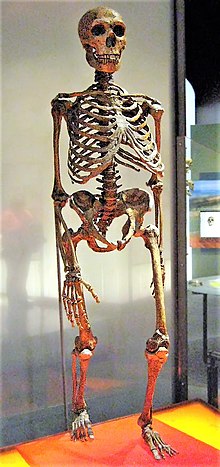
| |||||
| An approximate reconstruction of a Neanderthal skeleton. The central rib-cage (including the sternum) and parts of the pelvis are from modern humans. | |||||
| Scientific classification | |||||
| Kingdom: | Animalia | ||||
| Phylum: | Chordata | ||||
| Class: | Mammalia | ||||
| Order: | Primates | ||||
| Suborder: | Haplorhini | ||||
| Infraorder: | Simiiformes | ||||
| Family: | Hominidae | ||||
| Subfamily: | Homininae | ||||
| Tribe: | Hominini | ||||
| Genus: | Homo | ||||
| Species: | †H. neanderthalensis
| ||||
| Binomial name | |||||
| †Homo neanderthalensis King, 1864
| |||||
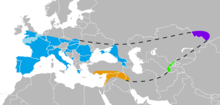
| |||||
| Known Neanderthal range in Europe (blue), Southwest Asia (orange), Uzbekistan (green), and the Altai Mountains (violet) | |||||
| Synonyms[6] | |||||
| https://en.wikipedia.org/wiki/Neanderthal | |||||
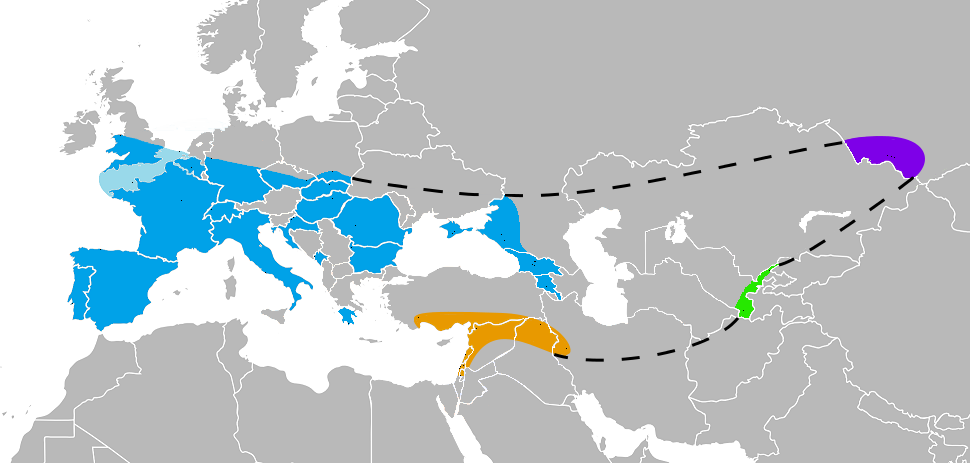 https://en.wikipedia.org/wiki/Neanderthal#/media/File:Range_of_NeanderthalsAColoured.png
https://en.wikipedia.org/wiki/Neanderthal#/media/File:Range_of_NeanderthalsAColoured.png


https://en.wikipedia.org/wiki/Neanderthal#/media/File:Homo_heidelbergensis._Museo_de_Prehistoria_de_Valencia.jpg
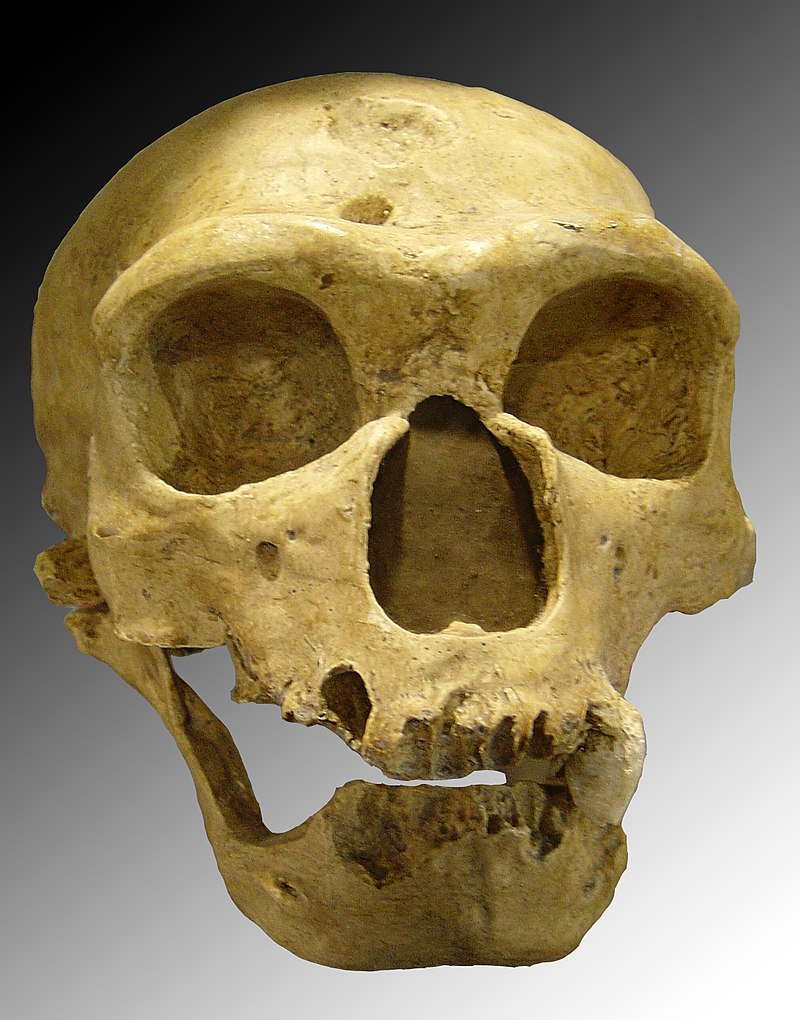
Stage 4: classic European Neanderthal (La Chapelle-aux-Saints 1, 50,000 years ago)
Startling discovery: Ancient mixed-race girl had Neanderthal and Denisovan parents - Genetic Literacy Project
Enzootic nasal adenocarcinoma is a fatal, malignant neoplastic, infectious disease in sheep and goats. It is caused by the Enzootic nasal tumor virus, a retrovirus similar to Jaagsiekte sheep retrovirus, which causes a similar disease, also in sheep and goats called Ovine pulmonary adenocarcinoma (OPA).[1] Symptoms include nasal discharge, dyspnea, facial deformity, and weight loss. Like OPA, the disease has a very long incubation period and is invariably fatal.[2]
See also
https://en.wikipedia.org/wiki/Enzootic_nasal_adenocarcinoma
The modern human Oase 2 skull (cast depicted), found in Peştera cu Oase, displays archaic traits due to possible hybridization with Neanderthals.[50]
Oase 2 Age: About 41,500–39,500 years old Site: Peştera cu Oase, Romania Year of Discovery: 2003 Discovered by: Ştefan Milota, Ricardo Rodrigo, Oana Moldovan and João Zilhão Age: About 41,500–39,500 years old Species: Homo sapiens This skull looks modern but retains a few archaic traits, such as wide cheek bones. Some scientists wonder if this means that on rare occasions Homo sapiens interbred with Neanderthals, who lived in Europe at the same time. Reference: Oase 2. Human Origins. Washington, DC: Smithsonian National Museum of Natural History. 30 March 2016.
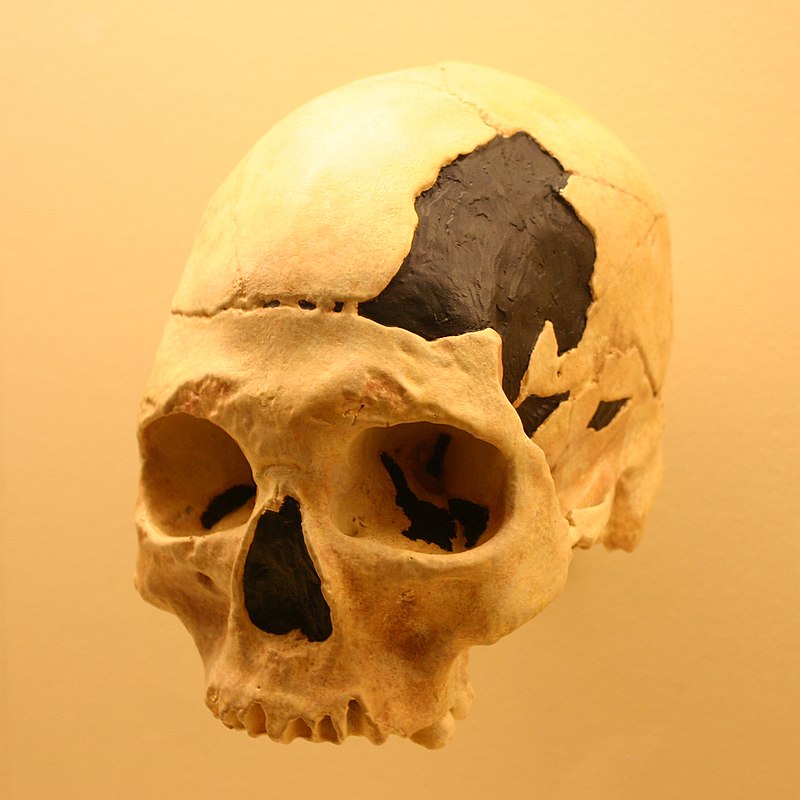
https://en.wikipedia.org/wiki/Interbreeding_between_archaic_and_modern_humans#/media/File:Oase_2-Homo_Sapiens.jpg
Le Moustier Neanderthal skull reconstitution, Neues Museum Berlin[28]

